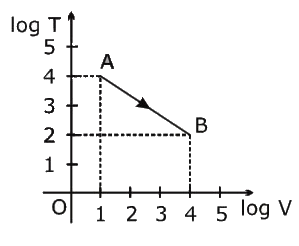The intercept of the line drawm for log P (P in atm) and log 1V (V in litre) for 1 mole of an ideal gas at 27∘C is equal to .
A
log2.463
B
log24.63
C
log22.4
D
log2.24
Video Solution
Text Solution
PV=K
or logP=logK+log.1V
Also PV=RT=0.0821×300=24.63
∴K=24.63 .
|
Updated on:21/07/2023
Topper's Solved these Questions
- BOOK - P BAHADURCHAPTER - GASEOUS STATEEXERCISE - Exercise B1videos
GASEOUS STATE
- BOOK - P BAHADURCHAPTER - GASEOUS STATEEXERCISE - Exercise 41videos
GASEOUS STATE
- BOOK - P BAHADURCHAPTER - GASEOUS STATEEXERCISE - Exercise 31videos
GASEOUS STATE
- BOOK - P BAHADURCHAPTER - CHEMICAL EQUILIBRIUMEXERCISE - Exercise134videos
CHEMICAL EQUILIBRIUM
- BOOK - P BAHADURCHAPTER - IONIC EQUILIBRIUMEXERCISE - Exercise85videos
IONIC EQUILIBRIUM
Similar Questions
Knowledge Check
- Question 1 - Select One
Calculate the difference between CpandCV for 10 mole of an ideal gas.
A83.14 JB8.314 JC831.4 JD0.8414 J - Question 2 - Select One
For an ideal gas Cp and Cv are related as
ACp−Cv=RBCpCv=RCCp+Cv=RDCv−Cp=R - Question 3 - Select One
At a constant pressure P, the plot of volume (V) as a function of temperature (T) for 2 moles of an ideal gas gives a straight line with a slope 0.328 L K−1. The value of P (in atm) is closest to [Gas constant, R = 0.0821 L atm mol−1 K−1]
A0.25B0.5C1.0D2.0
The slope of the graph between log P and log V at constant temperature for a given mass of gas is
View SolutionDraw a graph of logP and log(1/V) for a fixed amount of gas at constant temperature.
View SolutionIf V(x) is larger of ex−1and(1+x)log(1+x) for x∈(0,∞) then log (V (8) + 1) is equal to
View SolutionLog P vs log V curve is plotted for an ideal gas, which is true for the gas ?
 View Solution
View SolutionFigure shows, the adiabatic curve on a log T and log V scale performed on ideal gas. The gas is -
 View Solution
View Solution

